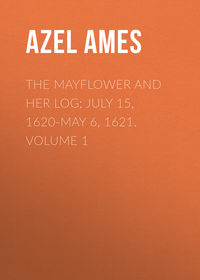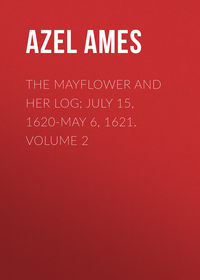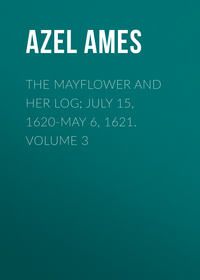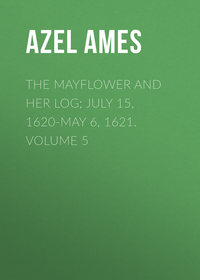 полная версия
полная версияThe Mayflower and Her Log; July 15, 1620-May 6, 1621. Volume 4
Master Christopher Martin, as previously noted, was from Billerica, in Essex. From collateral data it appears that he must have been "about forty" years old when he joined the Pilgrims. He appears to have been a staunch "Independent" and to have drawn upon himself the ire of the Archdeacon of Chelmsford, (probably) by his loud-mouthed expression of his views, as only "a month before the MAY-FLOWER sailed" he, with his son and Solomon Prower of his household (probably a relative), were cited before the archdeacon to answer for their shortcomings, especially in reverence for this church dignitary. He seems to have been at all times a self-conceited, arrogant, and unsatisfactory man. That he was elected treasurer and ship's "governor" and permitted so much unbridled liberty as appears, is incomprehensible. It was probably fortunate that he died early, as he did, evidently in utter poverty. He had a son, in 1620, apparently quite a grown youth, from which it is fair to infer that the father was at that time "about forty." Of his wife nothing is known. She also died early.
Solomon Prower, who is called by Bradford both "son" and "servant" of Martin, seems from the fact of his "citation" before the Archdeacon of Chelmsford, etc., to have been something more than a "servant," possibly a kinsman, or foster-son, and probably would more properly have been termed an "employee." He was from Billerica, in Essex, and was, from the fact that he did not sign the Compact, probably under twenty-one or very ill at the time. He died early. Of John Langemore, his fellow "servant," nothing is known, except that he is spoken of by Young as one of two "children" brought over by Martin (but on no apparent authority), and he did not sign the Compact, though this might have been from extreme illness, as he too died early.
William White was of the Leyden congregation. He is wrongly called by Davis a son of Bishop John White, as the only English Bishop of that name and time died a bachelor. At White's marriage, recorded at the Stadthaus at Leyden, January 27/February 1, 1612, to Anna [Susanna] Fuller, he is called "a young man of England." As he presumably was of age at that time, he must have been at least some twenty-nine or thirty years old at the embarkation, eight years later. His son Peregrine was born in Cape Cod harbor. Mr. White died very early.
Susanna (Fuller) White, wife of William, and sister of Dr. Fuller (?), was apparently somewhat younger than her first husband and perhaps older than her second. She must, in all probability (having been married in Leyden in 1612), have been at least twenty-five at the embarkation eight years later. Her second husband, Governor Winslow, was but twenty-five in 1620, and the presumption is that she was slightly his senior. There appears no good reason for ascribing to her the austere and rather unlovable characteristics which the pen of Mrs. Austin has given her.
Resolved White, the son of William and Susanna White, could not have been more than six or seven years old, and is set down by Goodwin and others—on what seems inconclusive evidence—at five. He was doubtless born at Leyden.
William Holbeck is simply named as "a servant" of White, by Bradford. His age does not appear, but as he did not sign the Compact he was probably "under age." From the fact that he died early, it is possible that he was too ill to sign.
Edward Thompson is named by Bradford as a second "servant" of Master White, but nothing more is known of him, except that he did not sign the Compact, and was therefore probably in his nonage, unless prevented by severe sickness. He died very early.
Master William Mullens (or Molines, as Bradford some times calls him) is elsewhere shown to have been a tradesman of some means, of Dorking, in Surrey, one of the Merchant Adventurers, and a man of ability. From the fact that he left a married daughter (Mrs. Sarah Blunden) and a son (William) a young man grown, in England, it is evident that he must have been forty years old or more when he sailed for New England, only to die aboard the ship in New Plymouth harbor. That he was not a French Huguenot of the Leyden contingent, as pictured by Rev. Dr. Baird and Mrs. Austin, is certain.
Mrs. Alice Mullens, whose given name we know only from her husband's will, filed in London, we know little about. Her age was (if she was his first wife) presumably about that of her husband, whom she survived but a short time.
Joseph Mullens was perhaps older than his sister Priscilla, and the third child of his parents; but the impression prevails that he was slightly her junior,—on what evidence it is hard to say. That he was sixteen is rendered certain by the fact that he is reckoned by his father, in his will, as representing a share in the planter's half-interest in the colony, and to do so must have been of that age.
Priscilla Mullens, whom the glamour of unfounded romance and the pen of the poet Longfellow have made one of the best known and best beloved of the Pilgrim band, was either a little older, or younger, than her brother Joseph, it is not certain which. But that she was over sixteen is made certain by the same evidence as that named concerning her brother.
Robert Carter is named by Bradford as a "man-servant," and Mrs. Austin, in her imaginative "Standish of Standish," which is never to be taken too literally, has made him (see p. 181 of that book) "a dear old servant," whom Priscilla Mullens credits with carrying her in his arms when a small child, etc. Both Bradford's mention and Mr. Mullens's will indicate that he was yet a young man and "needed looking after." He did not sign the Compact, which of itself indicates nonage, unless illness was the cause, of which, in his case, there is no evidence, until later.
Richard Warren, as he had a wife and five pretty well grown daughters, must have been forty-five or more when he came over. He is suggested to have been from Essex.
Stephen Hopkins is believed to have been a "lay-reader" with Mr. Buck, chaplain to Governor Gates, of the Bermuda expedition of 1609 (see Purchas, vol. iv. p. 174). As he could hardly have had this appointment, or have taken the political stand he did, until of age, he must have been at least twenty-one at that time. If so, he would have been not less than thirty two years old in 1620, and was probably considerably older, as his son Giles is represented by Goodwin ("Pilgrim Republic," p. 184) as being "about 15." If the father was but twenty-one when the son was born, he must have been at least thirty-seven when he became a MAY-FLOWER Pilgrim. The probabilities are that he was considerably older. His English home is not known. Professor Arber makes an error (The Story of the Pilgrim Fathers," p. 261) in regard to Hopkins which, unless noted, might lead to other and more serious mistakes. Noting the differences between John Pierce and a Master Hopkins, heard before the Council for New England, May 5/15, 1623, Arber designates Master Hopkins as "Stephen" (on what authority does not appear), and leaves us to infer that it was the Pilgrim Hopkins. On further inquiry it transpires that the person who was at variance with Master John Pierce over the matter of passage and freight money, on account of the unfortunate PARAGON, was a Rev. Master Hopkins (not Stephen of the MAY-FLOWER), who, we learn from Neill's "History of the Virginia Company," was "recommended July 3, 1622, by the Court of the Company to the Governor of Virginia, . . . being desirous to go over at his own charge. He was evidently a passenger on both of the disastrous attempts of the PARAGON under Captain William Pierce, and being forced back the second time, apparently gave up the intention of going.
Mrs. Elizabeth Hopkins, nothing is known concerning, except that she was not her husband's first wife. Sometime apparently elapsed between her husband's marriages.
Giles Hopkins we only know was the son of his father's first wife, and "about 15." An error (of the types presumably) makes Griffis ("The Pilgrims in their Three Homes," p. 176) give the name of Oceanus Hopkins's father as Giles, instead of Stephen. Constance (or Constantia) Hopkins was apparently about eleven years old in 1620, as she married in 1627, and probably was then not far from eighteen years old. Damaris Hopkins, the younger daughter of Master Hopkins, was probably a very young child when she came in the MAY-FLOWER, but her exact age has not been as certained. Davis, as elsewhere noted, makes the singular mistake of saying she was born after her parents arrived in New England. She married Jacob Cooke, and the ante- nuptial agreement of his parents is believed to be the earliest of record in America, except that between Gregory Armstrong and the widow Billington.
Edward Dotey is called by Bradford "a servant," but nothing is known of his age or antecedents. It is very certain from the fact that he signed the Compact that he was twenty-one. He was a very energetic man. He seems to have been married before coming to New England, or soon after.
Edward Leister (the name is variously spelled) was a "servant," by Bradford's record. He was doubtless of age, as he signed the Compact.
Master John Crackstone, being (apparently) a widower with a son, a child well grown, was evidently about thirty five years old when he embarked for New England. He left a daughter behind. He died early.
John Crackstone, Jr., was but a lad, and died early.
Master Edward Tilley (sometimes spelled Tillie) and his wife Ann seem to have been without children of their own, and as they took with them to New England two children who were their kindred, it may be inferred that they had been married some little time. It is hence probable that Mr. Tilley was in the neighborhood of thirty. His wife's age is purely conjectural. They were, Bradford states, "of the Leyden congregation."
Henry Sampson was apparently but a young English lad when he came over in the MAY-FLOWER with his cousins the Tilleys. As he married in 1636, he was probably then about twenty-one, which would make him five or six when he came over. Goodwin ("Pilgrim Republic," p. 184) says he was "six."
Humility Cooper is said by Bradford to have been a "cosen" of the Tilleys, but no light is given as to her age or antecedents. She was but a child, apparently. She returned to England very soon after the death of Mr. and Mrs. Tilley, and "died young."
Master John Tilley, having twice married, and having a daughter some fourteen years old, must have been over thirty-five years old when he sailed on the Pilgrim ship. His birthplace and antecedents are not known, but he was "of the Leyden congregation."
Mrs. Bridget (Van der Velde) Tilley was just possibly a second wife. Nothing is known concerning her except that she was of Holland, and that she had, apparently, no child.
Elizabeth Tilley is said by Goodwin (op. cit. p. 298) and others to have been fourteen years old at her parents' death in 1621, soon after the arrival in New England. She was the child of her father's first wife. She married John Howland before 1624. Historians for many years called her the "daughter of Governor Carver," but the recovery of Bradford's MS. "historie" corrected this, with many other misconceptions, though to some the error had become apparent before. Her will also suggests her age.
Francis Cooke's age in 1620 is fixed by his known age at his death ("about 81") in 1663. He was from the north of England, and long a member of Robinson's congregation, both in England and in Holland(?).
John Cooke, son of Francis, is known to have been about ten years old when he sailed with his father for America, as his parents did not marry before 1609. He was undoubtedly born at Leyden. He was long supposed to have been the last male survivor of the original passengers (dying at Dartmouth in 1695.)
James Chilton's antecedents and his age are quite unknown. He must have been at least fifty, as he had a married daughter in Leyden, according to Bradford. He died among the first, and there is nothing of record to inform us concerning him, except Bradford's meagre mention. He may have lived at Leyden.
Mrs. Chilton's given name is declared by one writer to have been Susanna, but it is not clearly proven. Whence she came, her ancestry, and her age, are alike unknown.
Mary Chilton was but a young girl in 1620. She married, before 1627, John Winslow, and was probably not then over twenty, nor over fourteen when she came with her parents in the MAY-FLOWER.
Thomas Rogers appears, from the fact that he had a son, a lad well-grown, to have been thirty or more in 1620. His birthplace, antecedents, and history are unknown, but he appears to have been "of the Leyden congregation." His wife arid children came later.
Joseph Rogers was only a "lad" aboard the MAY-FLOWER, but he left a considerable posterity. Nothing is surely known of him, except that he was Thomas's son.
Degory Priest had the distinction of being "freeman" of Leyden, having been admitted such, November 16, 1615. He was by occupation a "hatter," a man of some means, who left a wife and at least two children in Holland when he embarked for America. His known age at death gives his age at sailing but a few months previous. At his marriage in Leyden, October 4, 1611, he was called "of London." He was about thirty-two when he married. His wife (a widow Vincent) was a sister of Isaac Allerton, who also was married at the same time that he was. Goodwin ("Pilgrim Republic," p. 183) also gives his age as "forty-one." His widow remarried and came over later. Dexter ("Mourt's Relation," p. 69, note) states, quoting from Leyden MS. records, that "Degory Priest in April, 1619, calling himself a 'hatter,' deposes that he 'is forty years of age.'" He must, therefore, have been about forty-one when he sailed on the MAY- FLOWER, and forty-two years old at his death.
John Rigdale and his wife Alice afford no data. They both died early, and there is no record concerning either of them beyond the fact that they were passengers.
Edward Fuller and his wife have left us little record of themselves save that they were of Leyden, that he is reputed a brother of Dr. Samuel Fuller (for whom they seem to have named the boy they brought over with them,—leaving apparently another son, Matthew, behind), and that both died the first winter. He must have been at least twenty- five, judging from the fact that he was married and had two children, and was perhaps somewhat older (though traditionally represented as younger) than his brother. Neither his occupation nor antecedents are surely known.
Samuel Fuller—the son of Edward Fuller and his wife—is called by Bradford "a young child." He must have been some five or six years of age, as he married in 1635, fifteen years later, and would presumably have been of age, or nearly so.
Thomas Tinker's name, the mention of his "wife" and "son," the tradition that they were "of the Leyden congregation" (which is not sure), the certainty that they were MAY-FLOWER passengers,—on Brad ford's list,—and that all died early, are all we know of the Tinker family.
John Turner and his two sons we know little about. He seems to have been a widower, as no mention is found of his wife, though this is not certain. He was of the Leyden congregation, and evidently a man of some standing with the leaders, as he was made their messenger to Carver and Cushman in London, in June, 1620, and was apparently accustomed to travel. He appears to have had business of his own in England at the time, and was apparently a man of sober age. As he had three children,—a daughter who came later to New England, and two sons, as stated by Bradford,—it is probable that he was thirty or over. He and both his sons died in the spring of 1621.
Francis Eaton was of Leyden, a carpenter, and, having a wife and child, was probably a young man about twenty five, perhaps a little younger. He married three times.
Mrs. Sarah Eaton, wife of Francis, was evidently a young woman, with an infant, at the date of embarkation. Nothing more is known of her, except that she died the spring following the arrival at Plymouth.
Samuel Eaton, the son of Francis and his wife, Sarah, Bradford calls "a sucking child:" He lived to marry.
Gilbert Window was the third younger brother of Governor Edward Winslow, and is reputed to have been a carpenter. He was born on Wednesday, October 26, 1600, at Droitwitch, in Worcester, England. ("Winslow Memorial," vol. i. p. 23.) He apparently did not remain long in the colony, as he does not appear in either the "land division" of 1623 or the "cattle division" of 1627; and hence was probably not then in the "settlement," though land was later allowed his heirs, he having been an "original" voyager of the Plymouth colony. He was but twenty years and fifteen days old when he signed the Compact, but probably was—from his brother's prominence and his nearness to his majority—counted as eligible. Bradford states that he returned to England after "divers years" in New England, and died there. It has been suggested that he went very early to some of the other "plantations."
John Alden was of Southampton, England, was hired as "a cooper," was twenty-one years old in 1620, as determined by the year of his birth, 1599 ("Alden Memorial," p. 1), and became the most prominent and useful of any of the English contingent of the MAY FLOWER company. Longfellow's delightful poem, "The Courtship of Miles Standish," has given him and his bride, Priscilla Mullens, world- wide celebrity, though it is to be feared that its historical accuracy would hardly stand criticism. Why young Alden should have been "hired for a cooper at Southampton," with liberty to "go or stay" in the colony, as Bradford says he was (clearly indicating that he went to perform some specific work and return, if he liked, with the ship), has mystified many. The matter is clear, however, when it is known, as Griffis shows, that part of a Parliamentary Act of 1543 reads: "Whosoever shall carry Beer beyond Sea, shall find Sureties to the Customers (?) of that Port, to bring in Clapboard [staves] meet [sufficient] to make so much Vessel [barrel or "kilderkin"] as he shall carry forth." As a considerable quantity of beer was part of the MAY-FLOWER'S lading, and her consignors stood bound to make good in quantity the stave-stock she carried away, it was essential, in going to a wild country where it could not be bought, but must be "got out" from the growing timber, to take along a "cooper and cleaver" for that purpose. Moreover, the great demand for beer-barrel stock made "clapboard" good and profitable return lading. It constituted a large part of the FORTUNE'S return freight (doubtless "gotten out" by Alden), as it would have undoubtedly of the MAY-FLOWER'S, had the hardship of the colony's condition permitted.
Peter Browne we know little concerning. That he was a man of early middle age is inferable from the fact that he married the widow Martha Ford, who came in the FORTUNE in 1621. As she then was the mother of three children, it is improbable that she would have married a very young man. He appears, from certain collateral evidence, to have been a mechanic of some kind, but it is not clear what his handicraft was or whence he came.
John Billington (Bradford sometimes spells it Billinton) and his family, Bradford tells us, "were from London." They were evidently an ill- conditioned lot, and unfit for the company of the planters, and Bradford says, "I know not by what friend shuffled into their Company." As he had a wife and two children, the elder of whom must have been about sixteen years old, he was apparently over thirty- five years of age. There is a tradition that he was a countryman bred, which certain facts seem to confirm. (See land allotments for data as to age of boys, 1632.) He was the only one of the original colonists to suffer the "death penalty" for crime.
Mrs. Ellen (or "Elen") Billington, as Bradford spells the name, was evidently of comporting age to her husband's, perhaps a little younger. Their two sons, John and Francis, were lively urchins who frequently made matters interesting for the colonists, afloat and ashore. The family was radically bad throughout, but they have had not a few worthy descendants. Mrs. Billington married Gregory Armstrong, and their antenuptial agreement is the first of record known in America.
John Billington, Jr., is always first named of his father's two sons, and hence the impression prevails that he was the elder, and Bradford so designates him. The affidavit of Francis Billington (Plymouth County, Mass., Deeds, vol. i. p. 81), dated 1674, in which he declares himself sixty-eight years old, would indicate that he was born in 1606, and hence must have been about fourteen years of age when he came on the MAY-FLOWER to New Plymouth. If John, his brother, was older than he, he must have been born about 1604, and so was about sixteen when, he came to New England. The indications are that it was Francis, the younger son, who got hold of the gunpowder in his father's cabin in Cape Cod harbor, and narrowly missed blowing up the ship. John died before 1630. Francis lived, as appears, to good age, and had a family.
Moses Fletcher was of the Leyden company, a "smith," and at the time of his second marriage at Leyden, November 30/December 21, 1613, was called a "widower" and "of England." As he was probably of age at the time of his first marriage,—presumably two years or more before his last,—he must have been over thirty in 1620. He was perhaps again a widower when he came over, as no mention is made of his having wife or family. He was possibly of the Amsterdam family of that name. His early death was a great loss to the colony.
A Thomas Williams is mentioned by Hon. Henry C Murphy ("Historical Magazine," vol. iii. pp. 358, 359), in a list of some of Robinson's congregation who did not go to New England in either the MAY-FLOWER, FORTUNE, ANNE, Or LITTLE JAMES. He either overlooked the fact that Williams was one of the MAY-FLOWER passengers, or else there were two of the name, one of whom did not go. Nothing is known of the age or former history of the Pilgrim of that name. He died in the spring of 1621 (before the end of March). As he signed the Compact, he must have been over twenty-one. He may have left a wife, Sarah.
John Goodman we know little more about than that he and Peter Browne seem to have been "lost" together, on one occasion (when he was badly frozen), and to have had, with his little spaniel dog, a rencontre with "two great wolves," on another. He was twice married, the last time at Leyden in 1619. He died before the end of March, 1621. As he signed the Compact, he must have been over twenty-one.
Edward Margeson we know nothing about. As he signed the Compact, he was presumably of age.
Richard Britteridge affords little data. His age, birthplace, or occupation do not transpire, but he was, it seems, according to Bradford, the first of the company to die on board the ship after she had cast anchor in the harbor of New Plymouth. This fact negatives the pleasant fiction of Mrs. Austin's "Standish of Standish" (p. 104), that Britteridge was one of those employed in cutting sedge on shore on Friday, January 12. Poor Britteridge died December 21, three weeks earlier. He signed the Compact, and hence may be accounted of age at the landing at Cape Cod.
Richard Clarke appears only as one of the passengers and as dying before the end of March. He signed the Compact, and hence was doubtless twenty-one or over.
Richard Gardiner, we know from Bradford, "became a seaman and died in England or at sea." He was evidently a young man, but of his age or antecedents nothing appears. He signed the Compact, and hence was at least twenty-one years old.
John Alderton (sometimes spelled Allerton), we are told by Bradford,—as elsewhere noted,—"was hired, but was reputed one of the company, but was to go back, being a seaman and so, presumably, unmindful of the voyages, for the help of others." Whether Bradford intended by the latter clause to indicate that he had left his family behind, and came "to spy out the land," and, if satisfied, to return for them, or was to return for the counsel and assistance of Robinson and the rest, who were to follow, is not clear, but the latter view has most to support it. We learn his occupation, but can only infer that he was a young man over twenty-one from the above and the fact that he signed the Compact. It has been suggested that he was a relative of Isaac Allerton, but this is nowhere shown and is improbable. He died before the MAY-FLOWER returned to England.








